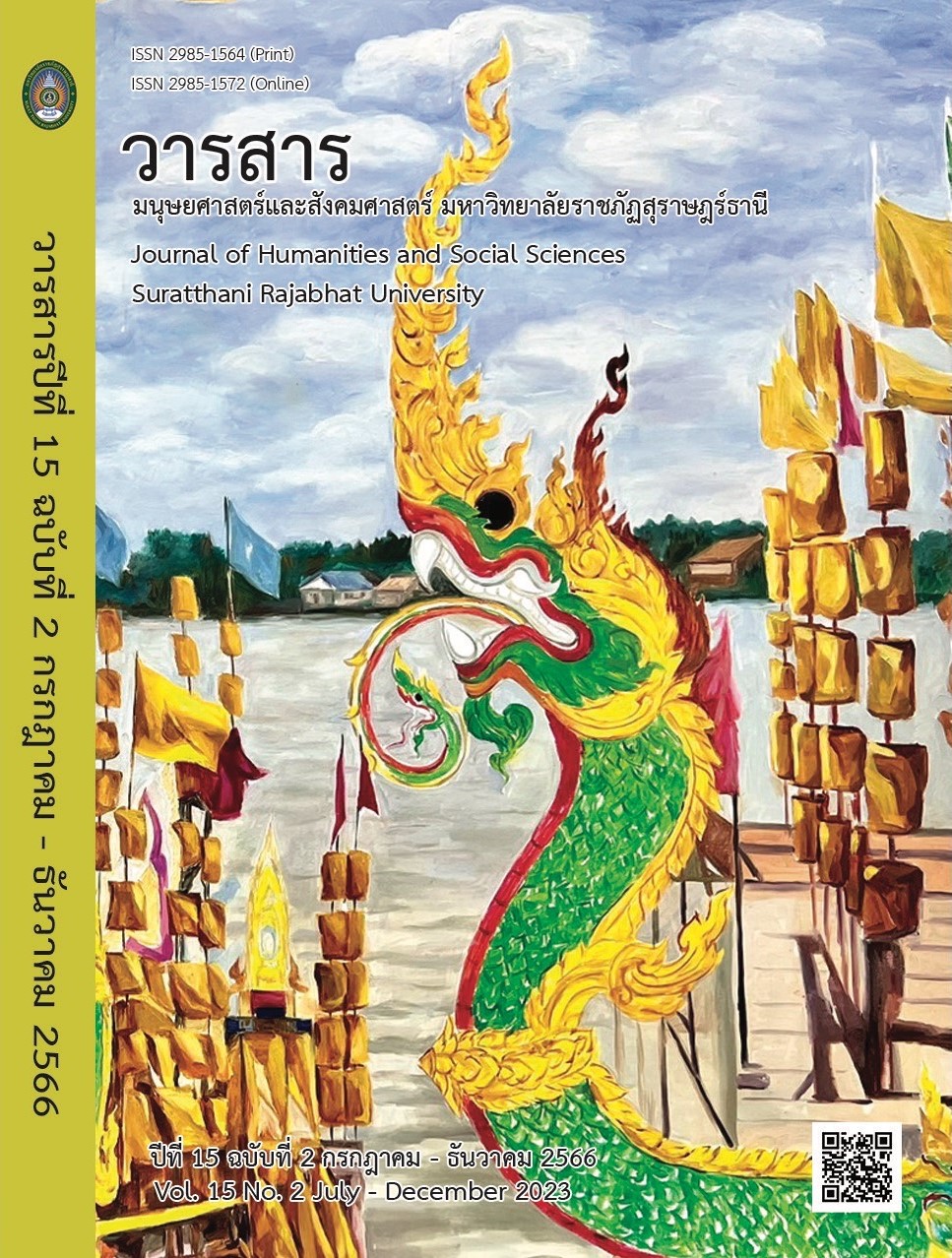The Songwriting Style of Thanakrit Panichwit
Main Article Content
Abstract
The research objective is to study the rhythmic language used in writing the songs of Thanakrit Panichwit. Qualitative research was conducted. There were four studio albums consisting of thirty-one songs by Thanakrit Panichwit, who is the only composer. The analysis of the songs of Thanakrit Panichwit employs the concept of language style, focusing on word usage, sentence usage, and the use of images. The results of the descriptive data analysis are presented.
The research results found that Thanakrit Panichwit's language styles in using words in songwriting have 13 aspects: 1) colloquial language, 2) rhyme words, 3) insertion words, 4) word duplication, 5) emotional words, 6) puns, 7) word segmentation, 8) archaic words, 9) dialects, 10) Word
coinage, 11) word order, 12) word combinations, and 13) different word class. Moreover, using sentences has three aspects: 1) using affirmative
sentences, 2) using imperative sentences, and 3) using interrogative
sentences. Also, there are eight aspects of using stylistic impressions:1) similes, 2) metaphors, 3) symbols, 4) hyperbole, 5) personification, 6) paradox,
7) oxymorons, and 8) rhetorical questions. The findings of this research
explain that Thanakrit Panichwit's songwriting emphasizes the use of
language that can convey meaning. It is easy for listeners to understand the song's mood. In addition, it also emphasizes the consistency between
language and music, which makes music beautiful in both literature and musical arts.
Article Details

This work is licensed under a Creative Commons Attribution-NonCommercial-NoDerivatives 4.0 International License.
All published manuscripts have been verified by peer-peer professors in the fields of humanities and social sciences. Reprinting of the article must be authorized by the editorial staff.
References
กุหลาบ มัลลิกะมาส. (2531). ความรู้ทั่วไปทางวรรณคดีไทย. กรุงเทพฯ: โรงพิมพ์
มหาวิทยาลัยรามคำแหง.
ขวัญใจ บุญคุ้ม. (2559). วัจนลีลาและบทบาทหน้าที่ของเพลงลูกทุ่ง. วิทยานิพนธ์ ศศ.ม.
(ภาษาไทย). เชียงใหม่: บัณฑิตวิทยาลัย มหาวิทยาลัยราชภัฏเชียงใหม่.
เขตต์อรัญ เลิศพิพัฒน์. (2545). คิดคำทำเพลง:ศิลปะการแต่งบทเพลงไทย. กรุงเทพฯ:
ชมรมคีตกวี.
บุญยงค์ เกศเทศ. (2525). วรรณกรรมวิเคราะห์. กรุงเทพฯ: โอเดียนสโตร์.
บุญยงค์ เกศเทศ. (2532). คำไทย. กรุงเทพฯ: โอเดียนสโตร์.
ปิยพันธ์ แสนทวีสุข. (2546). การประพันธ์เพลง. กาฬสินธุ์: ประสานการพิมพ์.
เปลื้อง ณ นคร. (2535). ศิลปะแห่งการประพันธ์. กรุงเทพฯ: ข้าวฟ่าง.
พิชญภณ ศรีนวล. (2554). วัจนลีลาในเพลงของบอย โกสิยพงษ์. วิทยานิพนธ์ ศศ.ม.
(ภาษาไทย). เชียงใหม่: บัณฑิตวิทยาลัย มหาวิทยาลัยเชียงใหม่.
สุทธิพงษ์ พิสิฐเสนากุล, ธนชาติ เกิดเกรียงไกร, และ รุจนี จีระกมล. (2563). การใช้ภาษาใน
บทเพลงไทยสากลที่เกี่ยวกับความผิดหวังในความรักซึ่งขับร้องโดยนักร้องชาย.
การประชุมวิชาการระดับชาติ สรรพศาสตร์ สรรพศิลป์ ประจำปี 2563.
กรุงเทพฯ: คณะศิลปศาสตร์ มหาวิทยาลัยธรรมศาสตร์.
อลิสา เลี้ยงรื่นรมย์. (2549). ลีลาภาษาในเพลงลูกทุ่งของ สลา คุณวุฒิ. วิทยานิพนธ์ ศศ.ม.
(ภาษาไทย). กรุงเทพฯ: บัณฑิตวิทยาลัย มหาวิทยาลัยเกษตรศาสตร์.
อาภาพร พันธุ์พฤกษ์. (2547). วัจนลีลาในวรรณกรรมเพลงเพื่อชีวิตของสุรชัย จันทิมาธร.
วิทยานิพนธ์ ศศ.ม. (ภาษาไทยเพื่อการสื่อสาร). สงขลา: บัณฑิตวิทยาลัย
มหาวิทยาลัยสงขลานครินทร์.
อิสราพร อนันตสุข. (2561). กลวิธีการใช้คำและการใช้ภาพพจน์ในเพลงของศิลปินนิวจิ๋ว.
การประชุมวิชาการและนำเสนอผลงานระดับชาติของนักศึกษาด้าน
มนุษยศาสตร์และสังคมศาสตร์ ครั้งที่ 1/2561. กรุงเทพฯ: คณะมนุษยศาสตร์
และสังคมศาสตร์ มหาวิทยาลัยราชภัฏสวนสุนันทา.


